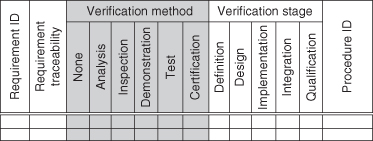4.2 PREPARE VVT PRODUCTS
4.2.1 Requirements Verification Matrix (RVM)
A Requirement Verification Matrix (RVM) is usually composed of (1) a requirement identification code, (2) requirement traceability to higher level documents, (3) verification methods to be used, (4) the stage(s) where verification takes place and (5) the verification procedure identification code. Verification methods often listed in the RVM are Analysis, Inspection, Demonstration, Testing and Certification (see typical RVM structure in Figure 4.1).
Figure 4.1 Typical RVM structure.

The following guidance is proposed in order to assign a specific verification method to a given system requirement:
Verification by Analysis
Heuristically, a system analysis method may be used:
- When other verification methods are not possible (e.g., verifying system reliability) or are too expensive (e.g., verifying system behavior in destructive conditions) or endanger humans or property (e.g., test flights outside the normal flight envelope).
- Based on the following means: mathematical models, simulations, algorithms, calculations, charts, graphs and so on.
Verification by Inspection
Heuristically, a system inspection method (illustrated in Figure 4.2) typically includes the use of human senses (e.g., sight, hearing, smell and/or touch) or simple physical tools for manipulation or mechanical and electrical gauging and measurements ...
Get Verification, Validation, and Testing of Engineered Systems now with the O’Reilly learning platform.
O’Reilly members experience books, live events, courses curated by job role, and more from O’Reilly and nearly 200 top publishers.

